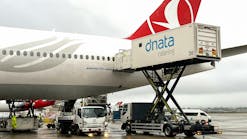Top Ground Handling Operations Trends for 2023 and Beyond
In recent years the ground handling industry has been on a steady rise, with the global airport ground handling market’s value reaching $31.8 billion in 2022. Industry projections suggest that this figure is set to reach $76.1 billion by the end of 2032, driven by a compound annual growth rate (CAGR) of 9.2 percent. Renata Sumskaite, the CEO of Sensus Aero, a new-gen software solution for the aviation industry, sheds light on major industry trends that support this impressive growth.
Addressing Labor Shortages and Knowledge Gaps
The aviation industry lost many ground-handling workers during the pandemic, and now, with aviation picking up again, there aren’t enough skilled staff, especially those with security clearances. And, unfortunately, passengers are already feeling delays. This shortage is a sign of deeper problems in finding and keeping good ground staff. But there are ways to fix this — the industry needs a better plan to attract new talent and keep current employees, simplify the onboarding process, and introduce retention programs that prioritize global standardization, improved work environments, flexible scheduling, and competitive wages.
Baggage Mishandling in the Era of Returning Passengers
In 2021, the number of mishandled baggage cases stood at 4.35 per one thousand passengers, marking a significant 24.3 percent increase from the previous year, according to SITA's 2022 Baggage IT Insights. The resurgence of air travel raises concerns about the potential for more baggage mishandling incidents. This highlights the industry's responsibility to take proactive measures to enhance baggage handling processes, reducing passenger inconvenience.
The Drive Toward Standardization
Industry standards are becoming fundamental in simplifying common processes, reducing costs, and enhancing collaboration between airlines, airports, ground service providers, cargo agents, freight forwarders, and governments. Recently, IATA reported that the IATA Ground Operations Manual (IGOM) Portal and IATA's Safety Audit for Ground Operations (ISAGO) are successfully driving greater standardization of ground handling processes worldwide. Increased participation in both programs bodes well for safety and efficiency, aiming to reduce risk, avoid ground damage, and enable standardized, sustainable operations.
Embracing Digitalization and Sustainability
With air travel passenger demand on the rise and the imminent arrival of new aircraft, airports face challenges of limited space, environmental concerns, and increased noise levels. Technological advancements, offer a lifeline, promising to improve sustainability and productivity by addressing issues like low airport capacity, congestion, and pollution, especially in ground operations. Ground handling operations are increasingly reliant on collecting data for improved safety and efficiency, enabling data-driven decisions that cut costs and align with the aviation industry's net-zero commitment.
As the airport ground handling industry looks ahead, it's crucial to address workforce issues, reduce the incidence of baggage mishandling, adopt standardized practices, and leverage the potential of digitalization and sustainability.




